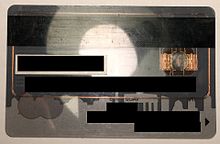Maestro card
Maestro is an international debit card service from Mastercard that enables cashless payments worldwide using a Maestro card (also known as Maestro card ) and the use of ATMs with the Maestro logo in the form of a payment card.
A debit card, also known as an ATM card in Austria, is a plastic card that allows direct and immediate access to the credit balance or the available credit line of the current account . However, it is not a credit card . In some countries it is common to equip cards of the respective national debit card system with Maestro functionality, which can be recognized by the additional Maestro logo on the card. For payments abroad, the Maestro application is used with these combined cards instead of the national system. A widespread example are German girocards with Maestro co-branding, which for this reason are often referred to as giro / Maestro cards or even Maestro cards by the issuing banks, which can lead to misunderstandings. In Germany, almost all cards are co-branded with Maestro.
VISA's European competitor system is V Pay . It is also mostly used in Germany as co-branding for girocards.
Functions

The Maestro application allows debit cards identified by the logo on the front of the card:
- Cashless electronic payments at more than 13.8 million acceptance points in retail (as of November 2011)
- Cash withdrawals at almost 1 million Maestro-enabled ATMs (as of October 2012)
Contactless payment is possible using the NFC Paypass payment system from Mastercard.
Transactions
In the case of Maestro transactions, the processing between the card issuing bank and the bank settling with the contractual partner or the ATM on-site bank is carried out by Mastercard . If Maestro is only available as co-branding on a card, the national system is usually used for payment, such as Girocard in Germany.
Maestro transactions are basically online transactions. This principle is broken if a card with an EMV chip is used at an EMV-capable terminal and the card-issuing bank does not want authorization due to certain criteria stored in the chip. Maestro transactions are usually confirmed with a PIN or, in the case of contactless payments, are authorized without checking the owner. Overseas, it is no longer possible to pay with a signature. Only in Europe are there a few countries in which, for historical reasons, signature-based transactions can also be carried out in addition to PIN transactions.
Maestro development
The number of Maestro cards has increased from 15 million (1993) to approx. 583 million (9/2009) worldwide (Switzerland: 5 million, Europe: 307 million). Maestro was introduced in Switzerland in 1998.
The number of terminals at Maestro contractual partners has increased since 1993 from just under 0.3 million at that time to around 11 million (9/2009) worldwide (Switzerland: 84,500, Europe: 6.5 million).
The number of cash dispensers with Maestro functionality was 440,000 worldwide at the end of 1998, and around one million in December 2010 (Switzerland: 6,200, Europe: 360,000).
With a Maestro card, you can now withdraw cash from exactly the same number of ATMs as you can with a Mastercard.
Maestro SecureCode for Internet payments
In Austria, the Maestro card could also be used to pay on the Internet. However, between the end of 2010 and the beginning of 2014 this service was discontinued by the banks. Since February 2014 some Austrian banks have been offering this service again for their Maestro cardholders. This time, too, the Mastercard SecureCode process is used.
For Germany there is now the possibility of internet payments with a card validation code . The widespread girocards with Maestro co-branding do not generally support payment in distance selling via Maestro, but this is possible with the pure Maestro card from N26 Bank GmbH.
Web links
- German website of Maestro (including international ATM search)
- Austrian website from Maestro
- Swiss website of Maestro
Individual evidence
- ↑ Maestro Germany: Archived copy ( Memento of the original dated June 5, 2012 in the Internet Archive ) Info: The archive link was inserted automatically and has not yet been checked. Please check the original and archive link according to the instructions and then remove this notice.
- ↑ Maestro Germany: Points of acceptance: http://www.maestrocard.com/de/uebermaestro/wissenswertes/akzeptanz.html
- ↑ a b c maestro.ch: Archived copy ( memento of the original from October 3, 2011 in the Internet Archive ) Info: The archive link was inserted automatically and has not yet been checked. Please check the original and archive link according to the instructions and then remove this notice.
- ^ Dominique Baumann: Payment transactions. In: Historical Lexicon of Switzerland . May 11, 2015 , accessed February 23, 2020 .
- ↑ C't : https://www.heise.de/ct/artikel/Der-Verlierer-zahlen-961969.html The loser pays - gap in the Maestro SecureCode system.


